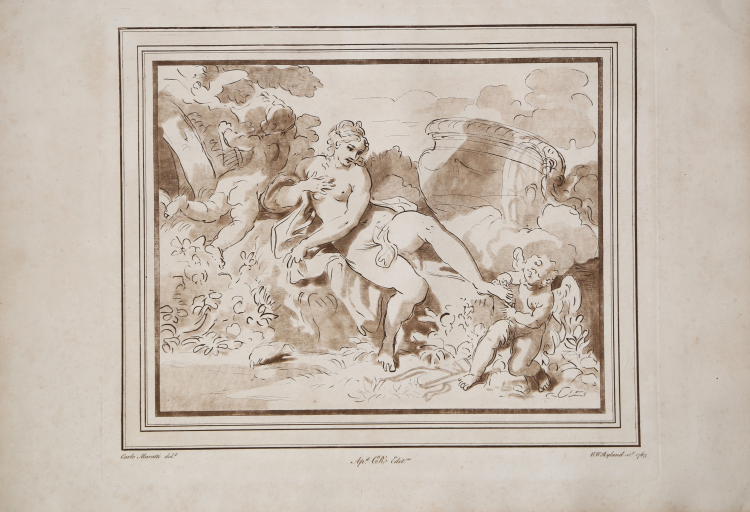




| Reference: | S49843 |
| Author | William Wynne Ryland |
| Year: | 1763 |
| Measures: | 390 x 335 mm |



| Reference: | S49843 |
| Author | William Wynne Ryland |
| Year: | 1763 |
| Measures: | 390 x 335 mm |
Venus lying on a bank, with Cupid plucking a thorn from her foot, with an amorino chasing a dove on the left; in rectangular frame imitating a wash mount.
After Carlo Maratti.
Etching and mezzotint, 1763, lettered below the image with production details: "Carlo Maratti delt / WW Ryland sct 1763 / Apd CR Editm".
From Tome I of Charles Rogers 'A Collection of Prints in Imitation of Drawings to which are annexed lives with explanatory and critical notes by Charles Rogers Esq. F.R.S. S.A.L. / Quantanus nobis denegatur diu viver relinquamus aliquid quo nos vixisse testemur. Plin. Lib. III.. Epist. 7 / Printed by J. Nicholls, Successor to Mr Bowyer & Sold by John Boydell, Engraver, No. 93, Cheapside. Benjamin White, at Horace's Head, Fleet-Street. Peter Molini, in Oxendon-Street, Hay-Market M.DCC.LXXVIII'.
The plates were engraved after drawings in major British collections, including Charles Rogers' own, and published in two volumes in London.
A very good impression on contemporary laid paper, with margins, a light foxing, otherwise in good condition.
William Wynne Ryland (Londra 1732 - 1783)
|
William Wynne Ryland was an English engraver, who pioneered stipple engraving and was executed for forgery. Ryland was born in London, the eldest of seven sons of Edward Ryland (died 1771), an engraver and copper-plate printer. He studied engraving under Ravenet in London, and, in Paris, drawing under François Boucher and engraving under Jacques-Philippe Le Bas. After spending five years on the continent he returned to England, and having engraved portraits of George III and Lord Bute (after Ramsay), and a portrait of Queen Charlotte and the Princess Royal after Francis Cotes, R.A., he was appointed engraver to the king - a position that carried a salary of £200 per annum.
In 1766 he became a member of the Incorporated Society of Artists, and he exhibited with them and in the Royal Academy. In his later life Ryland abandoned line engraving, and introduced chalk-engraving, in which the line is composed of stippled dots, and in which he transcribed Mortimer's "King John Signing Magna Carta", and copied the drawings of the Old Masters and the works of Angelica Kauffman.
Ryland became prosperous, and seeking an investment, went into partnership with a pupil, Henry Bryer, putting his money into a print shop in Cornhill, London; the business went bankrupt in December 1771. After an interval, he resumed business as a print-seller in the Strand, but before long retired to a private residence at Knightsbridge.
|
William Wynne Ryland (Londra 1732 - 1783)
|
William Wynne Ryland was an English engraver, who pioneered stipple engraving and was executed for forgery. Ryland was born in London, the eldest of seven sons of Edward Ryland (died 1771), an engraver and copper-plate printer. He studied engraving under Ravenet in London, and, in Paris, drawing under François Boucher and engraving under Jacques-Philippe Le Bas. After spending five years on the continent he returned to England, and having engraved portraits of George III and Lord Bute (after Ramsay), and a portrait of Queen Charlotte and the Princess Royal after Francis Cotes, R.A., he was appointed engraver to the king - a position that carried a salary of £200 per annum.
In 1766 he became a member of the Incorporated Society of Artists, and he exhibited with them and in the Royal Academy. In his later life Ryland abandoned line engraving, and introduced chalk-engraving, in which the line is composed of stippled dots, and in which he transcribed Mortimer's "King John Signing Magna Carta", and copied the drawings of the Old Masters and the works of Angelica Kauffman.
Ryland became prosperous, and seeking an investment, went into partnership with a pupil, Henry Bryer, putting his money into a print shop in Cornhill, London; the business went bankrupt in December 1771. After an interval, he resumed business as a print-seller in the Strand, but before long retired to a private residence at Knightsbridge.
|